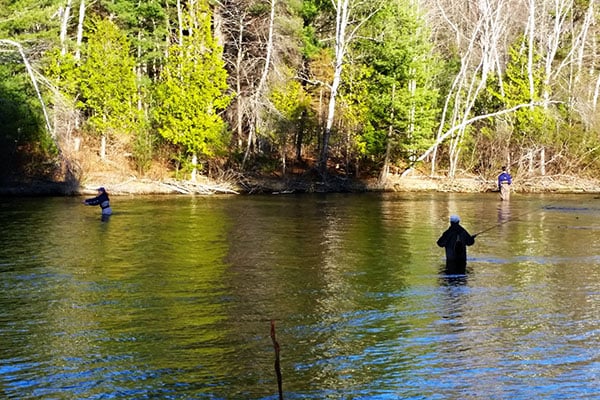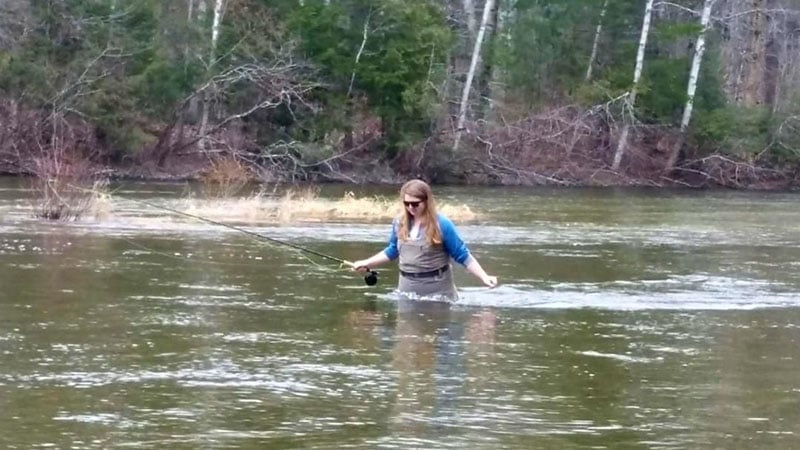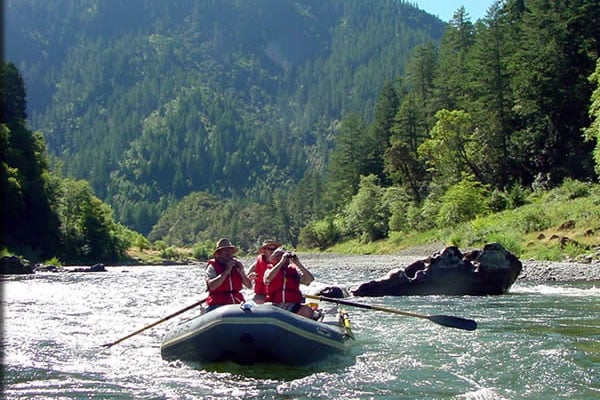Last Updated on
Have you been thinking of learning how to fly fish? I decided one frigid, windy April day while standing on the dam between Grand Lake Stream and West Grand Lake that I would learn to fly fish that year. The fly fishermen below the dam were casting gracefully, gently cradling their landlocked Atlantic salmon in one hand while releasing them with the other, never lifting them out of the water. I wanted to be there with them.
The idea of learning to fly fish was bigger in my mind than it is in reality. I asked friends what I needed to get started and was surprised by how short the list was when I combined all they told me. Keep it simple in the beginning. Try fly fishing on for size. If you like it you can upgrade. If possible, borrow or rent what you can to minimize the cost. Or hire a guide who’ll provide everything you need as well as a casting lesson.
If you’re going to get started by standing in cold water during spring you’ll need waders, probably insulated but maybe not. My daughter Taylor can stand in icy Grand Lake Stream on April 1 in uninsulated waders. I want as much insulation as possible. Keep your personal tolerance of cold in mind. Some waders come with boots attached while others have separate boots. Try both to find out what you like best.
If you’re starting out in warmer water, you can wear shorts or light pants and sandals or sneakers. Or, you can skip standing in water and fly fish from shore or a boat.
You’ll need a fly rod and reel. You can buy a perfectly good fly rod and reel combo for $100. I’m still using mine in my third year of fly fishing while I look at Tenkara rods.
Flies are artificial lures that resemble the fish’s natural food, usually insects. Ask the local fly fishermen and store what flies are working at the time. Small stores often have an assortment of flies in stock and there’s sure to be someone standing around with a cup of coffee and a fish story who’ll help you. If you can’t ask, wing it. Buy an inexpensive assortment of colors and sizes.
A case for your flies is handy but you can use any container. A case gives you a place to embed hooks and keeps them separate and easy to see. A small case can cost as little as .99 cents.
You’ll want a net. If your line isn’t set up with something called a Fast Snap or Quick Clip to make changing flies easy, you’ll want a pair of snips or fingernail clippers to cut the line. Have an extra tippet, just in case. Don’t forget a reliable pair of fishing pliers.
Written out here the list seems long. It’s waders, sandals or nothing at all; fly rod and reel, lures, a net, and snips. Don’t forget your fishing license and a rule book.
If you have access to a fly rod and reel you can practice casting. If you don’t have someone to teach you the basics you can find dozens of tutorial videos online. I recommend working with someone who knows how to cast well so he or she can get you off to a strong start. Ask the person to point out your mistakes so you don’t develop a bad habit you later have to break. Start casting in a wide open space so you don’t get hung up. Your lawn is a convenient place to start. Boat landings with gentle inclines work well and so do docks. You can stand in a boat, and if you’re comfortable in a kayak or canoe, you’re all set. Move away from objects and people, especially if those people are also casting.
Accept help from experienced fly fishermen who offer up advice. I hired a guide for my first trip because I knew the cold, fast-moving stream and lack of experience could cause a disaster. On my second trip a generous angler approached me in the stream and asked if I’d like to learn how to catch a fish. “I’d like to learn to cast well,” was my reply. I was lifting my elbow too high so he suggested I use my elbow to hold my net against my hip. Simple tips like this make a big difference.
If you discover you enjoy fly fishing and are going to continue you’ll want a vest to hold your fly cases, snippers, Fast Snaps and net. Invest in waders if you’ll need them, and you’re ready to go.














